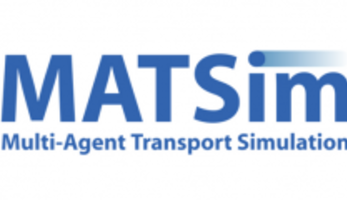MATSim – Multi-Agent Transport Simulation
Basic Information
Language
English
Latest update
Price
Free of charge
Application time
2 months for simple, small models, up to 6 months to build a complex model of a large region.
Assistance required
Due to the powerful features, the complexity of the software is not to be underestimated. This means a long learning curve is required to master the tool. This learning curve can be shortened by getting external assistance
Assistance data
Road network; Population data; Mobility behaviour (e.g. travel diary); Public Transport Schedule (optional); Buildings / Facilities (optional); Transit, taxi, or private vehicles (optional)
Tool type
Other
Application area
- Other
Target Audience
- Metropolitan regions
Summary
MATSim is an open-source framework to implement large-scale agent-based transport simulations, where a large number of individual, synthetic persons (so-called “agents”) are simulated.
The framework is designed for large-scale scenarios, meaning that all features of the model are stripped down to efficiently handle the targeted functionality. For the network loading simulation, for example, a queue-based model is implemented, omitting very complex and computationally expensive car-following behaviour.
MATSim is typically used to simulate a single day, but multi-day applications could be implemented by minor modifications to the (open) source code of the tool.
MATSim is based on the co-evolutionary principle. Every agent repeatedly optimises its daily activity schedule while competing for space-time slots with all other agents on the transportation infrastructure. This is somewhat similar to the route assignment iterative cycle, but goes beyond route assignment by incorporating other choice dimensions like time choice, mode choice or destination choice into the iterative loop.
The MATSim Book (http://www.matsim.org/the-book) contains a lot more details, explaining the different parts and modules that are part of MATSim.
Good Example
MATSim is used world-wide for various, transport modelling-related use cases, like city- or nation-wide multi-modal transport planning, evacuation planning, public transport (incl. fleets of autonomous vehicles) or freight planning. It includes modules to compute particulate emissions, noise, or accessibility.
The page www.matsim.org/scenarios has a list of several applications along with short descriptions, many of them described in more detail in part 4 of the MATSim Book (http://www.matsim.org/the-book)
Thematic areas
Collective passenger transport & shared mobility
Demand & urban space management
Behavioural change & mobility management
Urban logistics
- Distribution consolidation schemes
Integrated & inclusive planning
Contacts
MATSim Community, strongly backed by Technical University of Berlin, ETH Zurich, Senozon AG
Prof Dr Kai Nagel, nagel [at] vsp.tu-berlin.de; Dr Marcel Rieser, rieser
0







